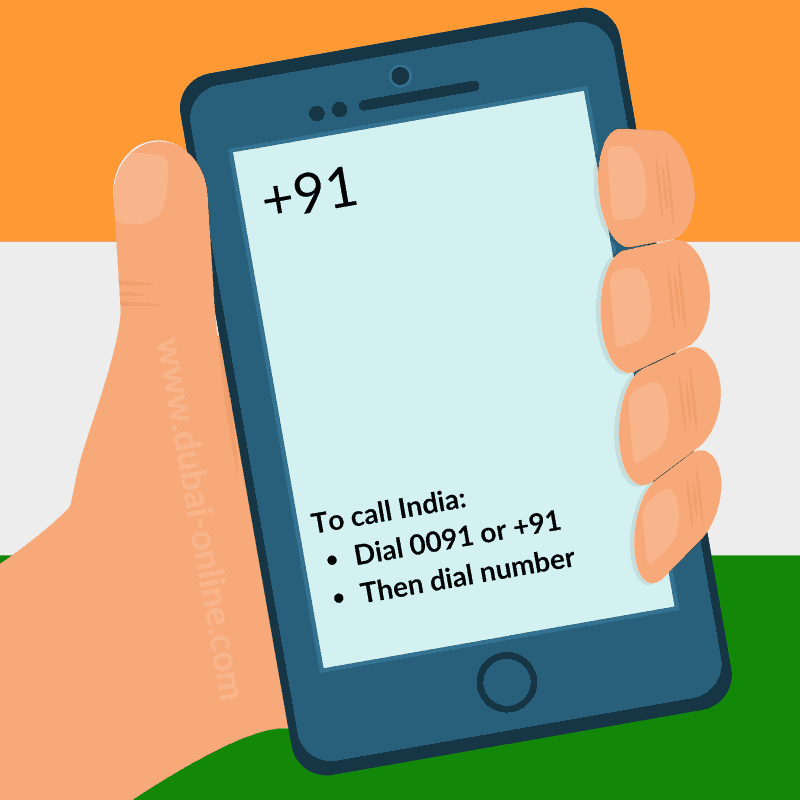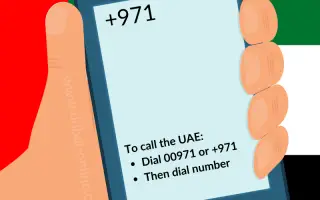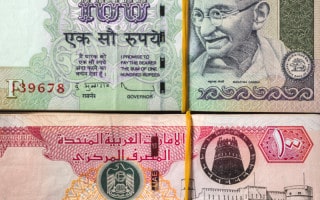It’s a simple task to make a phone call to India, but there are a few things you need to know before making the call.
The first thing you need is the country code for India. This is 91.
You also need to know the international call prefix. This is 00 (or + from a mobile phone).
Armed with this knowledge, it’s easy to make a phone call to India.
Landlines – City/Area Codes in India
Landline numbers in India are 10 digits long (area code + subscriber number).
Area codes for the biggest cities are 2 digits long. Smaller cities and large towns have area codes that are 3 digits in length.
Area codes for a selection of cities in India are listed below:
- Agra – 562
- Ahmedabad – 79
- Bangalore (Bengaluru) – 80
- Bhopal -755
- Chennai (Madras) – 44
- Faridabad – 129
- Ghaziabad – 120
- Hyderabad – 40
- Indore – 731
- Jaipur -141
- Kalyan-Dombivli – 251
- Kanpur – 512
- Kolkata (Calcutta) – 33
- Lucknow – 522
- Ludhiana – 161
- Meerut – 121
- Mumbai – 22
- Nagpur -712
- Nashik – 253
- New Delhi – 11
- Patna – 612
- Pimpri-Chinchwad – 20
- Pune – 20
- Rajkot – 281
- Ranchi – 651
- Surat – 261
- Thane – 22
- Vadodara – 265
- Vasai-Virar – 250
- Visakhapatnam – 891
A 0 prefix before the area code is used when calling a landline number from a different area within India or an Indian mobile.
Do not dial the 0 prefix or area code when telephoning from a landline in the same area.
Do not add a 0 prefix to the area code when calling from overseas.
For example, to call a number in Mumbai XXXXXXXX:
- From a landline in Mumbai dial XXXXXXXX.
- From a landline in India outside Mumbai, dial 0-22-XXXXXXXX.
- From a mobile phone in India, dial 0-22-XXXXXXXX.
- From overseas, dial the international call prefix (00/+), the country code for India (91), the area code without the 0, and then the subscriber number e.g. 00-91-22-XXXXXXXX or +91-22-XXXXXXXX.
Mobile Telephone Numbers in India
Mobile phone numbers in India are 10 digits long.
They begin with 6, 7, 8, or 9.
To call a mobile phone number in India from overseas, dial the international exit call prefix (00/+), the India country code (91), and then the subscriber number e.g. 00-91-XXXXXXXXXX or +91- XXXXXXXXXX.

Landline Usage in India
Data from the World Bank shows that in 2022 there were 1.94 landline telephone subscribers for every 100 people living in India.
In 2003 there were 3.76 fixed-line telephone subscriptions for every 100 people living in India.
The table below shows how fixed-line phone subscription statistics have changed in recent years.
| Year | Landline Telephone Subscriptions (per 100 People) in India |
|---|---|
| 2022 | 1.94 |
| 2021 | 1.69 |
| 2020 | 1.44 |
| 2019 | 1.52 |
| 2018 | 1.60 |
| 2017 | 1.72 |
| 2016 | 1.82 |
| 2015 | 1.93 |
| 2014 | 2.07 |
| 2013 | 2.25 |
| 2012 | 2.43 |
| 2011 | 2.61 |
| 2010 | 2.83 |
| 2009 | 3.03 |
| 2008 | 3.14 |
| 2007 | 3.30 |
| 2006 | 3.48 |
| 2005 | 4.35 |
| 2004 | 4.07 |
| 2003 | 3.76 |
Landline use in India is on the decline as mobile phone usage increases.
The advancement of mobile network technology has made mobile phones more appealing than fixed lines. Mobile phones are more portable and offer more features than landlines. As a result, people are increasingly choosing mobile phones over landlines. The number of mobile phone subscribers in India has been growing rapidly in recent years.
Mobile Phone Usage in India
According to the World Bank, there were 80.65 mobile phone subscribers per 100 people in 2022.
This is a big increase from 2003 when there were 3.01 mobile phone subscribers for every 100 people.
Mobile telephone subscription statistics by year for India are shown in the table below.
| Year | Mobile Phone Subscriptions (per 100 People) in India |
|---|---|
| 2022 | 80.65 |
| 2021 | 81.99 |
| 2020 | 82.62 |
| 2019 | 83.25 |
| 2018 | 85.90 |
| 2017 | 86.32 |
| 2016 | 84.25 |
| 2015 | 75.67 |
| 2014 | 72.21 |
| 2013 | 68.65 |
| 2012 | 67.85 |
| 2011 | 71.08 |
| 2010 | 60.63 |
| 2009 | 42.91 |
| 2008 | 28.75 |
| 2007 | 19.64 |
| 2006 | 14.16 |
| 2005 | 7.81 |
| 2004 | 4.60 |
| 2003 | 3.01 |
Internet Usage in India
According to statistics from the World Bank, in 2021 46.31 per cent of the population of India used the internet.
This is a significant increase from 2002 when only 1.54 per cent of the population were active internet users.
Internet usage statistics in recent years are shown in the table below.
| Year | Individuals Using the Internet in India (% of Population) |
|---|---|
| 2021 | 46.31 |
| 2020 | 43.41 |
| 2019 | 29.52 |
| 2018 | 20.08 |
| 2017 | 18.20 |
| 2016 | 16.50 |
| 2015 | 14.90 |
| 2014 | 13.50 |
| 2013 | 12.30 |
| 2012 | 11.10 |
| 2011 | 10.07 |
| 2010 | 7.50 |
| 2009 | 5.12 |
| 2008 | 4.38 |
| 2007 | 3.95 |
| 2006 | 2.81 |
| 2005 | 2.39 |
| 2004 | 1.98 |
| 2003 | 1.69 |
| 2002 | 1.54 |
The internet has become an increasingly important part of everyday life in India.
There are many reasons for this growth. Firstly, the price of internet-enabled devices has fallen sharply in recent years. This has made them more affordable for a wider range of people. Secondly, the infrastructure for delivering internet access has improved greatly. This has made it easier and quicker for people to get online.
Finally, and perhaps most importantly, the range of content and services available online has increased dramatically. There is now something for everyone. Whether you’re looking for entertainment, education or even just a way to stay in touch with friends and family, the internet has it all.
The internet has brought many benefits to India, including improved access to information and education, increased opportunities for businesses and entrepreneurs, and improved communication and connectivity.
Time Difference
When calling India from the United Arab Emirates, please note there is a time difference between India and the UAE.
The current time in the UAE is . The date is .
The time in India is now . The date is .
The time difference between UAE and India is 1.5 hours.
Exchange Rate
The official currency of India is the Indian rupee (INR).
Current exchange rates between the UAE dirham and the Indian rupee (INR to AED, AED to INR) are:
- 1 Indian rupee (INR) = 0.044 AED
- 1 UAE dirham (AED) = 22.72 INR
Exchange rates on this page were last updated on .
Useful Information
India is located in Southern Asia With a population of over 1.3 billion people, it is the second most populous country in the world
The country covers an area of almost 3.3 million square kilometres. It has land borders with China, Nepal, Bhutan, Bangladesh, Myanmar, Pakistan, and Afghanistan. India’s maritime borders include Sri Lanka.
The capital of India is New Delhi. Other major Indian cities include Mumbai, Kolkata, Hyderabad, Chennai and Bangalore.
Many languages are spoken in India. There are two official languages at the federal level; Hindi and English.
The country is home to many different religions including Hinduism (about 80% of the population), Islam (14%) and Christianity (2%).
Useful information about India:
- Two-letter Country Code (ISO 3166-1 alpha-2): IN
- Three-letter Country Code (ISO 3166-1 alpha-3): IND
- Region: Asia
- Sub-region: Southern Asia
- Capital: New Delhi
- Area: 3,287,590 square km
- Language(s): Hindi, English
- Borders: Afghanistan, Bangladesh, Bhutan, Myanmar, China, Nepal, Pakistan, Sri Lanka
Data from the World Bank shows that in 2022 the population of India was 1,417,173,173.
In 2003, the population was 1,117,415,123. Over the last 20 years, the population grew by 299,758,050 (26.8%).
The table below shows how the total population has changed in recent years.
| Year | Total Population of India |
|---|---|
| 2022 | 1,417,173,173 |
| 2021 | 1,407,563,842 |
| 2020 | 1,396,387,127 |
| 2019 | 1,383,112,050 |
| 2018 | 1,369,003,306 |
| 2017 | 1,354,195,680 |
| 2016 | 1,338,636,340 |
| 2015 | 1,322,866,505 |
| 2014 | 1,307,246,509 |
| 2013 | 1,291,132,063 |
| 2012 | 1,274,487,215 |
| 2011 | 1,257,621,191 |
| 2010 | 1,240,613,620 |
| 2009 | 1,223,640,160 |
| 2008 | 1,206,734,806 |
| 2007 | 1,189,691,809 |
| 2006 | 1,172,373,788 |
| 2005 | 1,154,638,713 |
| 2004 | 1,136,264,583 |
| 2003 | 1,117,415,123 |
Map of India
The location of India can be seen on the map below.


